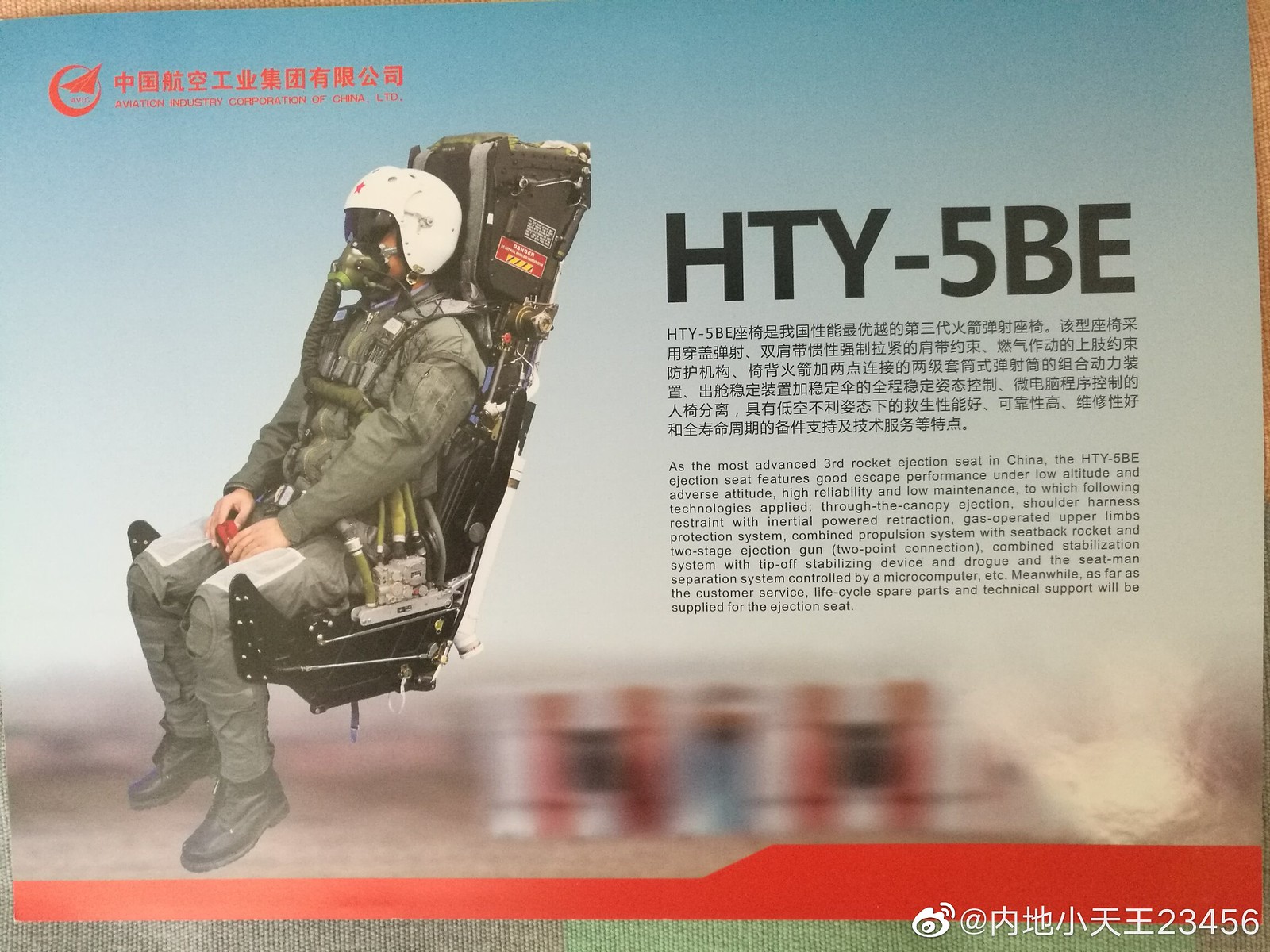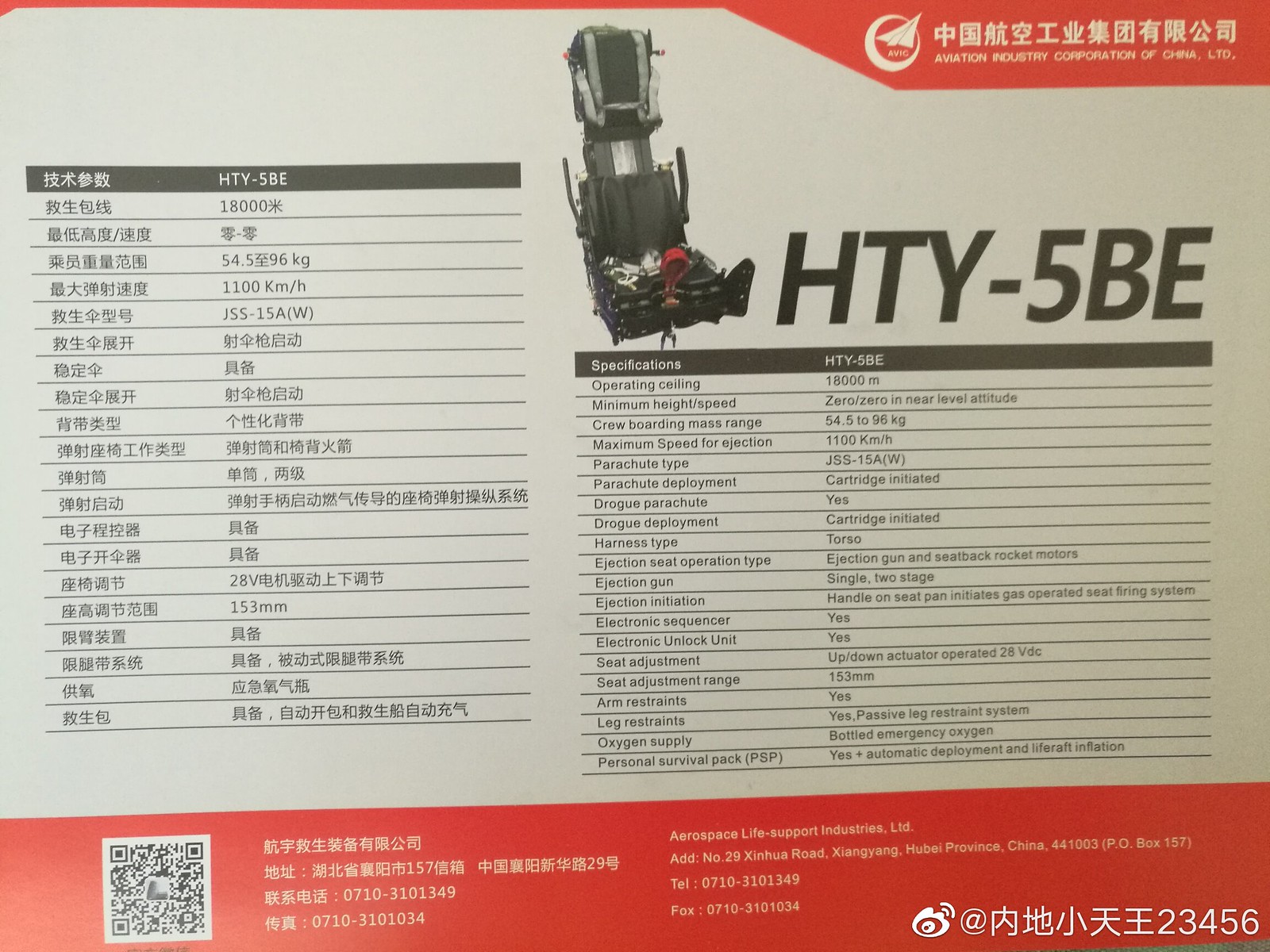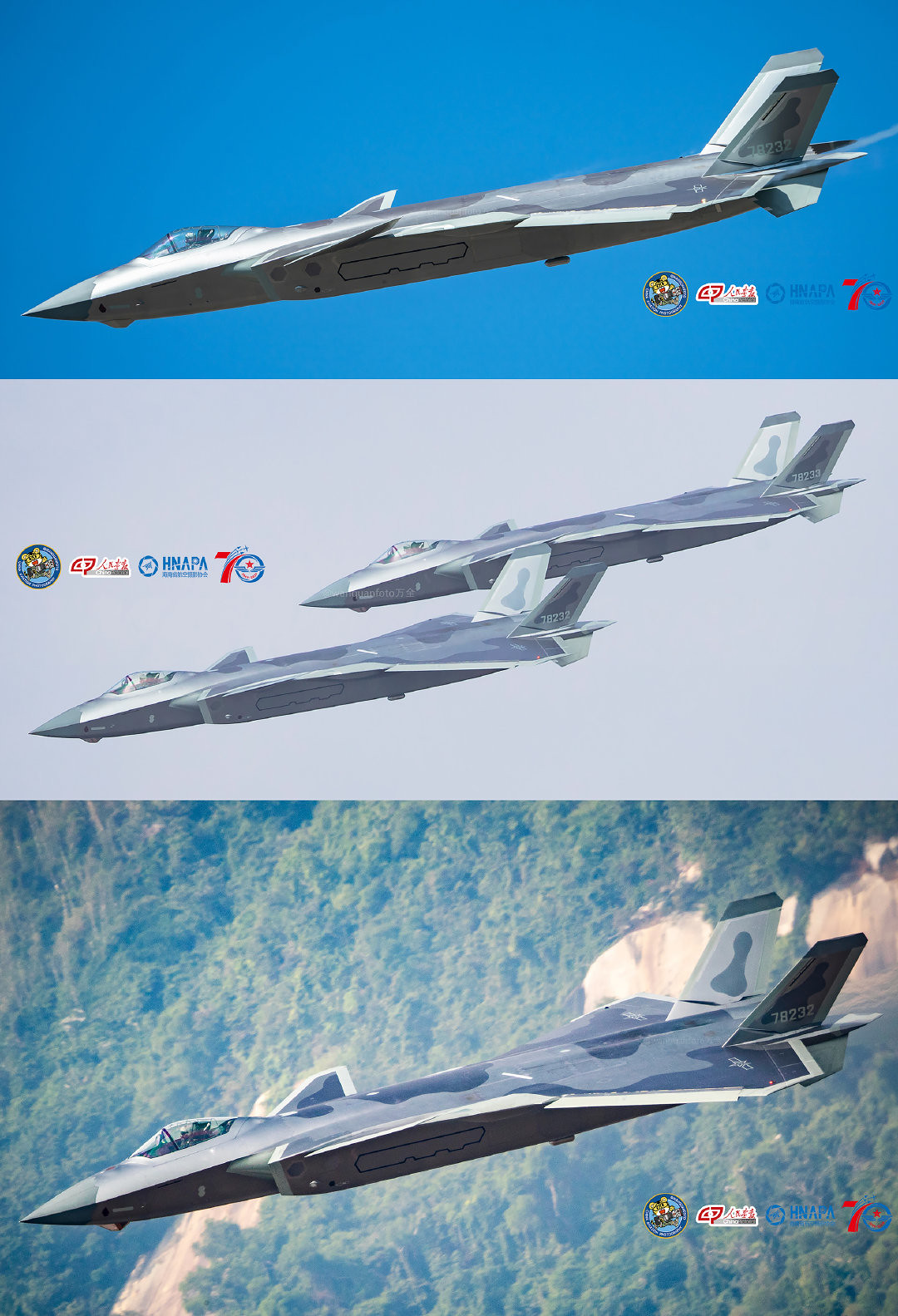You are using an out of date browser. It may not display this or other websites correctly.
You should upgrade or use an alternative browser.
You should upgrade or use an alternative browser.
J-20 5th Generation Fighter VII
- Thread starter siegecrossbow
- Start date
- Status
- Not open for further replies.
The problem with a twin-seated J-20 is that when you're doing stealth aircraft modifying any part of the shape requires extensive work and re-engineering due to the shaping aspect of the stealth formula.
The other objection to the drone control and AEW&C is, isn't it simpler to put the aircraft on autopilot while the AEW&C / command and control pilot performs command and drone control tasks?
The other objection to the drone control and AEW&C is, isn't it simpler to put the aircraft on autopilot while the AEW&C / command and control pilot performs command and drone control tasks?
The problem with a twin-seated J-20 is that when you're doing stealth aircraft modifying any part of the shape requires extensive work and re-engineering due to the shaping aspect of the stealth formula.
The other objection to the drone control and AEW&C is, isn't it simpler to put the aircraft on autopilot while the AEW&C / command and control pilot performs command and drone control tasks?
In a high intensity scenario, there may be a need to perform a standard A2A mission while also performing battle management and/or drone control may not allow for an aircraft to be placed on autopilot.
I also expect a single seater J-20 will still be able to perform the battle management and drone control role, but with less ability to multitask than a twin seater, where the rate limiting step is the number of humans.
Of course, you can only add additional copilots to a certain extent where the structural changes are impractical and/or not worth the development costs or penalties in other capability domains.
It will remain to be seen whether the costs of developing a twin seater will be deemed worth the benefits -- and I personally am a bit skeptical -- but given who these rumours came from means we are obligated to treat it as part of the conversation now.
The ideal implementation of the twin-seater is simply to modify the pilot bubble; i.e, to change seating configurations without changing the location of and dimensions of the pilot bubble. This may result in less space for pilot or co-pilot, but the J-20 is a 20.4-20.7 meter aircraft. Changing its dimensions, on the other hand, is going to be more difficult as there's EODAS mounted directly behind the J-20's pilot canopy, which will require reprogramming and debugging of the new EODAS location.
The problem with putting a J-20 into a C2 role is about the same as the problem with a Y-8 running command and control. The Y-8 immediately becomes a target because it allows command and control of the air unit to be decapitated. The J-20, likewise, is going to have compromised maneuverability and performance due to the increased weight. It is also, since it contains a valuable cargo, going to be deployed more defensively and thus compromise its role as a fighter.
The main advantage of a J-20 over a Y-8 in a command and control role is speed and stealth. The Y-8 is not a stealthy aircraft, and it's basically a subsonic transport / bomber. The J-20 is slated to have supercruise.
I'd see the goal of a twin-seater J-20 as for creating a training or strike aircraft, something quite divergent from the J-20A/B's main role.The twin-seater might end up being repurposed for command-and-control, but that's only because trainer models are already up and somewhat compromised vs standard J-20s.
The problem with putting a J-20 into a C2 role is about the same as the problem with a Y-8 running command and control. The Y-8 immediately becomes a target because it allows command and control of the air unit to be decapitated. The J-20, likewise, is going to have compromised maneuverability and performance due to the increased weight. It is also, since it contains a valuable cargo, going to be deployed more defensively and thus compromise its role as a fighter.
The main advantage of a J-20 over a Y-8 in a command and control role is speed and stealth. The Y-8 is not a stealthy aircraft, and it's basically a subsonic transport / bomber. The J-20 is slated to have supercruise.
I'd see the goal of a twin-seater J-20 as for creating a training or strike aircraft, something quite divergent from the J-20A/B's main role.The twin-seater might end up being repurposed for command-and-control, but that's only because trainer models are already up and somewhat compromised vs standard J-20s.
The ideal implementation of the twin-seater is simply to modify the pilot bubble; i.e, to change seating configurations without changing the location of and dimensions of the pilot bubble. This may result in less space for pilot or co-pilot, but the J-20 is a 20.4-20.7 meter aircraft. Changing its dimensions, on the other hand, is going to be more difficult as there's EODAS mounted directly behind the J-20's pilot canopy, which will require reprogramming and debugging of the new EODAS location.
The problem with putting a J-20 into a C2 role is about the same as the problem with a Y-8 running command and control. The Y-8 immediately becomes a target because it allows command and control of the air unit to be decapitated. The J-20, likewise, is going to have compromised maneuverability and performance due to the increased weight. It is also, since it contains a valuable cargo, going to be deployed more defensively and thus compromise its role as a fighter.
The main advantage of a J-20 over a Y-8 in a command and control role is speed and stealth. The Y-8 is not a stealthy aircraft, and it's basically a subsonic transport / bomber. The J-20 is slated to have supercruise.
I'd see the goal of a twin-seater J-20 as for creating a training or strike aircraft, something quite divergent from the J-20A/B's main role.The twin-seater might end up being repurposed for command-and-control, but that's only because trainer models are already up and somewhat compromised vs standard J-20s.
I don't think the reprogramming of the aft EO PDS aperture would be an insurmountable challenge, it will require reworking of the programming, but that's just going to be one of the costs of entry if they want a twin seater.
The difference between a J-20 twin seater and a Y-8 running command control is that the former is going to be much more survivable than the latter in the air warfare battlespace of the near future where 5th generation fighters are going to be common place.
While a twin seater J-20 will obviously be less maneuvrable than a single seater, it is a matter of comparison in terms of the additional battle management and drone command capabilities vs a single seater, as well as the enhanced degree of survivability vs a standard Y-9 style airframe.
Putting it another way, "compromise" is relative.
A twin seater J-20 obviously won't be used to directly confront opposing A2A fighters if it can be helped, but it can operate as a survivable and a lethal self defending force multiplier for friendly A2A fighters (as well as other friendly multi domain assets), and for drones once they emerge.
Seeing a twin seater J-20 less as a standard A2A fighter but more as a combat capable trainer and as a survivable and persistent/self defending force multiplier asset would make its "compromises" seem significantly more appropriate.
I doubt a twin seater J-20 (assuming no other airframe/structural modifications beyond the requisite modifications for a second seat, which the rumours haven't suggested) will be a strike aircraft. The weapons bay of J-20 will allow provisions for small diameter direct attack weapons and stand off powered weapons developed dedicated for its weapons bay, but the number of munitions it will be able to accommodate should be more than easily able to be managed by a single pilot while doing the other tasks of the aircraft.
A twin seater J-20 will certainly have a training role to expedite the training of new pilots.
Last edited:
I've mentioned already that the J-20 would have speed and stealth advantages over a Y-8; i.e, its survivability would be greater as it would be harder to put a missile track on the J-20 comppred to a J-20, and the better kinematics means that the effective range of a missile targeting a J-20 would be much reduced.
But the J-20 also has drawbacks compared to a Y-8. The Y-8 is not a stealth platform, meaning that it would be considerably cheaper. The Y-8 can carry more electronics and crew, as well as providing a more comfortable working environment for command staff working in the Y-8.
There are considerable advantages of a Y-8 compared to a J-20, that means that putting the J-20 as a twin-seater simply to provide a command position makes no sense.
It's the combination of the training and command and control capabilities that justify a twin-seat J-20; i.e, its primary role would be as a trainer, but I wouldn't be surprised if command and control capabilities came up to add more capability to the jet.
You have to think of the scenario. Since a twin-seat J-20 is going to be used more cautiously than a twin-seat J-20 due to its command and control roles, the pilot in front is relegated to the role of a driver, a task that can be fulfilled easily by an autopilot. Why add the stealth penalty and weight penalty of hauling a driver along, when an autopilot can do the job for a flight leader?
Lastly, I know you are very aghast at the notion of the J-20 fulfilling any strike functions, given that initial Western media coverage downplayed its role as a fighter. Still, stand-off powered weapons for the J-20's weapons bay is more or less the same thing as stand-off powered weapons for the F-35, which we know is a strike fighter.
The more practical expectation of a strike variant of the J-20 would be weapons bay enlargement (4+2 with current PL-15s is a bit low, and as I've mentioned, the J-20 weapons bay is a bit too short for a Kh-91). The problem becomes then that the J-20 would need considerable redesign on top of merely changing the pilot bubble to accommodate a larger weapons bay. A simpler solution may be to reinforce the wings to support external weapons carriage a la the F-35.
But the J-20 also has drawbacks compared to a Y-8. The Y-8 is not a stealth platform, meaning that it would be considerably cheaper. The Y-8 can carry more electronics and crew, as well as providing a more comfortable working environment for command staff working in the Y-8.
There are considerable advantages of a Y-8 compared to a J-20, that means that putting the J-20 as a twin-seater simply to provide a command position makes no sense.
It's the combination of the training and command and control capabilities that justify a twin-seat J-20; i.e, its primary role would be as a trainer, but I wouldn't be surprised if command and control capabilities came up to add more capability to the jet.
You have to think of the scenario. Since a twin-seat J-20 is going to be used more cautiously than a twin-seat J-20 due to its command and control roles, the pilot in front is relegated to the role of a driver, a task that can be fulfilled easily by an autopilot. Why add the stealth penalty and weight penalty of hauling a driver along, when an autopilot can do the job for a flight leader?
Lastly, I know you are very aghast at the notion of the J-20 fulfilling any strike functions, given that initial Western media coverage downplayed its role as a fighter. Still, stand-off powered weapons for the J-20's weapons bay is more or less the same thing as stand-off powered weapons for the F-35, which we know is a strike fighter.
The more practical expectation of a strike variant of the J-20 would be weapons bay enlargement (4+2 with current PL-15s is a bit low, and as I've mentioned, the J-20 weapons bay is a bit too short for a Kh-91). The problem becomes then that the J-20 would need considerable redesign on top of merely changing the pilot bubble to accommodate a larger weapons bay. A simpler solution may be to reinforce the wings to support external weapons carriage a la the F-35.
I've mentioned already that the J-20 would have speed and stealth advantages over a Y-8; i.e, its survivability would be greater as it would be harder to put a missile track on the J-20 comppred to a J-20, and the better kinematics means that the effective range of a missile targeting a J-20 would be much reduced.
But the J-20 also has drawbacks compared to a Y-8. The Y-8 is not a stealth platform, meaning that it would be considerably cheaper. The Y-8 can carry more electronics and crew, as well as providing a more comfortable working environment for command staff working in the Y-8.
There are considerable advantages of a Y-8 compared to a J-20, that means that putting the J-20 as a twin-seater simply to provide a command position makes no sense.
If you agree regarding that a twin seater J-20 will have substantially enhanced survivability compared to a Y-8/9 airframe then I'm not sure what further questions you have?
After all, a notional twin seater J-20 won't be replacing your Y-9 based AEW&C and battle management platforms, rather it'll be complementing/supplementing those existing aircraft, as one of those roles.
No one is suggesting that if a twin seater J-20 is introduced with a battle management role that the PLA are going to no longer fly KJ-500s or their other aerial GX platforms.
It's the combination of the training and command and control capabilities that justify a twin-seat J-20; i.e, its primary role would be as a trainer, but I wouldn't be surprised if command and control capabilities came up to add more capability to the jet.
This has already been discussed on previous pages.
J-20 5th Generation Fighter VII
As I wrote previously, if a twin seater combat capable J-20AS is able to do all three jobs of "combat capable trainer" + "drone commander" + "forward air commander" then I think I think all three of those benefits may be significant enough to make development of a twin seater viable and desirable.
If a J-20AS was "only" able to do one of the above roles then IMO it wouldn't have been worth developing a whole separate twin seater variant. But a twin seater variant able to do all of those tasks would probably be a far more attractive proposition.
You have to think of the scenario. Since a twin-seat J-20 is going to be used more cautiously than a twin-seat J-20 due to its command and control roles, the pilot in front is relegated to the role of a driver, a task that can be fulfilled easily by an autopilot. Why add the stealth penalty and weight penalty of hauling a driver along, when an autopilot can do the job for a flight leader?
A twin seater J-20 may be used more cautiously than a single seat J-20, however it will still be expected to operate in an air combat environment close to where opfor 5th generation fighters will be contesting airspace.
In other words, the pilot in a twin seater J-20 will still be expected to do the job of a pilot in a single seater J-20, while the copilot/controller will be able to conduct additional battle management tasks or drone control tasks, which an aircraft with only a single seat alone wouldn't be capable of doing at the same degree.
Lastly, I know you are very aghast at the notion of the J-20 fulfilling any strike functions, given that initial Western media coverage downplayed its role as a fighter. Still, stand-off powered weapons for the J-20's weapons bay is more or less the same thing as stand-off powered weapons for the F-35, which we know is a strike fighter.
From the very beginning, I have said that I expect J-20 to have a secondary strike role, through the use of small diameter direct attack munitions as well as stand off powered weapons designed for J-20's weapons bay. There's a big difference between my belief that J-20 will have a secondary strike role versus western media suggesting it was a dedicated strike aircraft.
I'm not sure why you are insisting on incorrectly portraying my position, and it's become a tiring straw man at this point.
The more practical expectation of a strike variant of the J-20 would be weapons bay enlargement (4+2 with current PL-15s is a bit low, and as I've mentioned, the J-20 weapons bay is a bit too short for a Kh-91). The problem becomes then that the J-20 would need considerable redesign on top of merely changing the pilot bubble to accommodate a larger weapons bay. A simpler solution may be to reinforce the wings to support external weapons carriage a la the F-35.
This is immaterial to the conversation about the idea of a twin seater J-20, because yankee describes it as a twin seater J-20 and not an aircraft with more extensive modifications to make it an enhanced strike variant which would require substantially greater airframe redesign.
- Status
- Not open for further replies.




